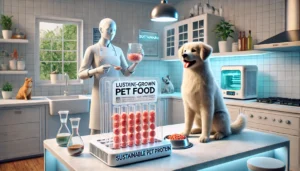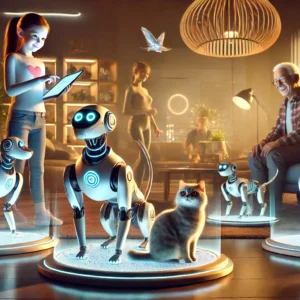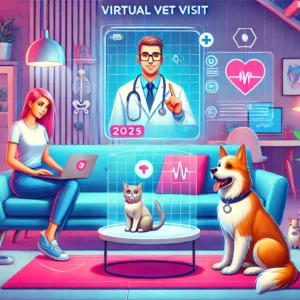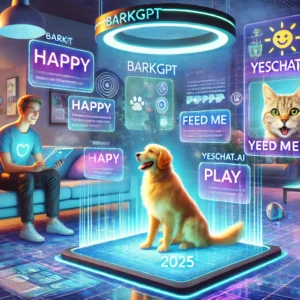
In 2025, the world of pet care is evolving in unexpected ways. One of the most fascinating developments is the rise of lab-grown pet foods—a sustainable and innovative solution that could revolutionize the way we feed our furry companions. As environmental concerns and ethical considerations gain momentum, lab-grown pet food offers a more sustainable, cruelty-free, and efficient alternative to traditional animal-based pet food production.
In this article, we’ll explore the rise of lab-grown pet foods, their potential to change the pet food industry, and the impact they may have on society, politics, and the economy.
What Are Lab-Grown Pet Foods?
Lab-grown pet foods are made using cellular agriculture, which involves growing animal cells in controlled environments to produce meat without the need to raise and slaughter animals. This innovative approach promises a more ethical and sustainable method of producing protein sources for pet foods. The concept is similar to lab-grown meat for human consumption, but tailored specifically to meet the nutritional needs of pets.
Unlike conventional pet foods that rely on animal farming, lab-grown options can significantly reduce the environmental footprint associated with meat production. The process involves cultivating cells from animals in bioreactors, where they grow into muscle tissue, which is then processed into pet food. This method drastically reduces the amount of land, water, and energy needed compared to traditional farming practices.
Government and Regulatory Involvement
The rise of lab-grown pet foods has drawn significant attention from both governments and regulatory bodies worldwide. In the United States, the FDA (Food and Drug Administration) has set guidelines for the safe production of lab-grown food, including pet food. These regulations aim to ensure that lab-grown products are safe for animal consumption and meet nutritional standards. The FDA’s approval process includes thorough safety assessments to ensure that lab-grown meats are free of harmful contaminants and allergens.
On a global scale, Europe has taken a slightly different approach. In 2023, the Czech company Bene Meat received approval from the European Union to sell lab-grown meat as a pet food ingredient. This decision marked a significant milestone for the industry. However, not all countries are as open to this technology. For instance, Italy recently moved to ban lab-grown meat, citing concerns about food sovereignty and the preservation of traditional farming methods. This political divide reflects the complexities of integrating new food technologies into global markets.
Scientists and Research Labs Paving the Way
Researchers around the world are diligently working to optimize lab-grown pet foods to make them a viable alternative to conventional pet food. Leading the charge in this field are labs such as Eat Just and Upside Foods, which have focused primarily on human-grade lab-grown meat. However, as the demand for sustainable pet food grows, many of these labs are adapting their methods to cater specifically to the pet food industry.
Dr. Maria Thompson, a prominent researcher in animal nutrition, highlights the importance of this shift:
“Lab-grown pet food offers a solution to some of the most pressing issues in pet care today—sustainability, nutritional adequacy, and ethical concerns. We are entering a new era where we can provide high-quality food for pets without the environmental and ethical compromises associated with traditional meat production.”
Ongoing studies focus on improving the taste, texture, and nutritional profile of lab-grown pet food to match the preferences of pets while ensuring it supports their health in the long term.
Celebrity Endorsements and Public Interest
The trend of sustainable pet care is gaining traction not only in the scientific community but also in popular culture. Celebrities like Emma Watson and Chris Hemsworth, who are vocal advocates for ethical food choices, have shown support for lab-grown pet foods. Emma Watson, in particular, shared her excitement about lab-grown meat for pets on social media, praising its ability to reduce the environmental impact of pet food production.
“As a pet owner, I always strive to make choices that are environmentally friendly, and lab-grown pet food aligns perfectly with those values. It’s thrilling to see how technology is reshaping the future of pet care.”
Celebrity endorsements have helped increase public awareness and foster a shift toward more sustainable pet care practices, especially among younger audiences who prioritize ethical consumerism.
The Generational Divide: Older vs. Younger Perspectives
While lab-grown pet foods might seem like the future, opinions about their adoption vary across generations.
Older Generations
For older pet owners, traditional pet food remains the norm. Many are skeptical about new technologies, especially when it comes to food. “I’ve always fed my pets what’s been available at the store. Why change now?” says Alice, a retired schoolteacher and pet owner. Older generations often value familiarity and are cautious about new technologies, particularly in areas as personal as pet food.
However, many older pet owners also recognize the growing importance of sustainability and ethical choices, and they are beginning to warm up to the idea of lab-grown alternatives.
Younger Generations
Younger generations, particularly Gen Z and Millennials, are far more open to lab-grown pet food. For them, sustainability and ethical considerations are not just trends—they are core values. Many young pet owners are already committed to plant-based diets for themselves and are naturally inclined to explore lab-grown options for their pets as well.
In a recent survey, 80% of Millennials stated they would consider purchasing lab-grown pet food due to its lower environmental impact. “If I can feed my dog sustainably while knowing I’m not harming animals, I’m all for it,” says Liam, a 28-year-old pet owner.
The Economic Impact: A Growing Market
The lab-grown pet food market is expanding rapidly, with some estimates predicting that it could become a multi-billion-dollar industry by 2030. Investors and businesses are seeing the immense potential in this sector, as pet ownership continues to rise worldwide. According to a report by Grand View Research, the global pet food market, including lab-grown alternatives, is expected to grow at a compound annual growth rate (CAGR) of 7.2% from 2025 to 2030.
Startups are popping up across the globe, competing for a share of the market. Companies like Wild Earth and Furvenza are already offering lab-grown protein products to pet owners. Additionally, established players in the pet food industry are investing in lab-grown technologies, signaling a shift toward more sustainable solutions.
Ethical and Environmental Considerations
One of the driving forces behind the lab-grown pet food movement is its potential to address environmental and ethical concerns. Traditional pet food production is a resource-intensive industry, contributing to deforestation, water shortages, and greenhouse gas emissions. By producing meat through cellular agriculture, lab-grown pet foods could significantly reduce the carbon footprint associated with feeding pets.
However, there are still challenges ahead. While lab-grown pet food is certainly more sustainable than conventional alternatives, the process of producing the food still requires significant amounts of energy, especially in the early stages of development. Researchers continue to work on reducing these energy costs, with the ultimate goal of making lab-grown pet food as eco-friendly as possible.
Frequently Asked Questions (FAQs)
Q: Are lab-grown pet foods safe for my pets?
A: Yes, lab-grown pet foods are carefully tested for safety and nutritional adequacy. Regulatory agencies like the FDA ensure that these products meet stringent safety standards.
Q: Will my pet like lab-grown food?
A: Lab-grown pet food is designed to be palatable for pets, with the same flavors and textures they enjoy in conventional pet foods. However, some pets may need time to adjust to the new food.
Q: Is lab-grown pet food more expensive?
A: Currently, lab-grown pet food can be more expensive than traditional pet food, but prices are expected to decrease as production scales up and technology improves.
Q: Can lab-grown pet food be used for all types of pets?
A: While most lab-grown pet food is designed for dogs and cats, research is ongoing to develop lab-grown options for other pets, such as birds and small mammals.
Conclusion
Lab-grown pet foods represent a fascinating and sustainable shift in how we feed our pets. With the potential to reduce environmental harm, improve animal welfare, and offer healthier, more nutritious alternatives to traditional pet food, it’s no surprise that this technology is gaining momentum. As the industry grows, it will be exciting to see how these innovations continue to shape the future of pet care.




